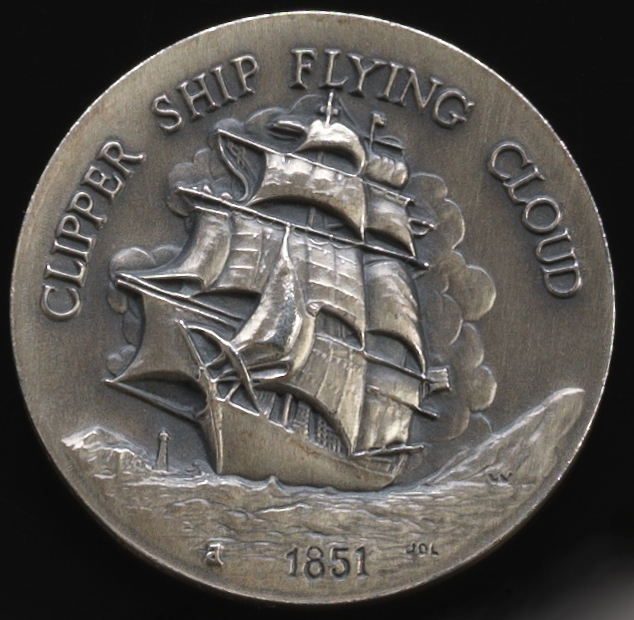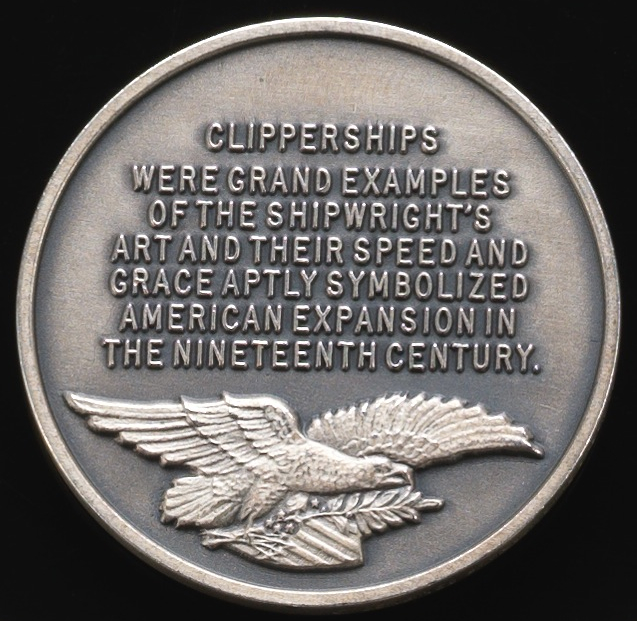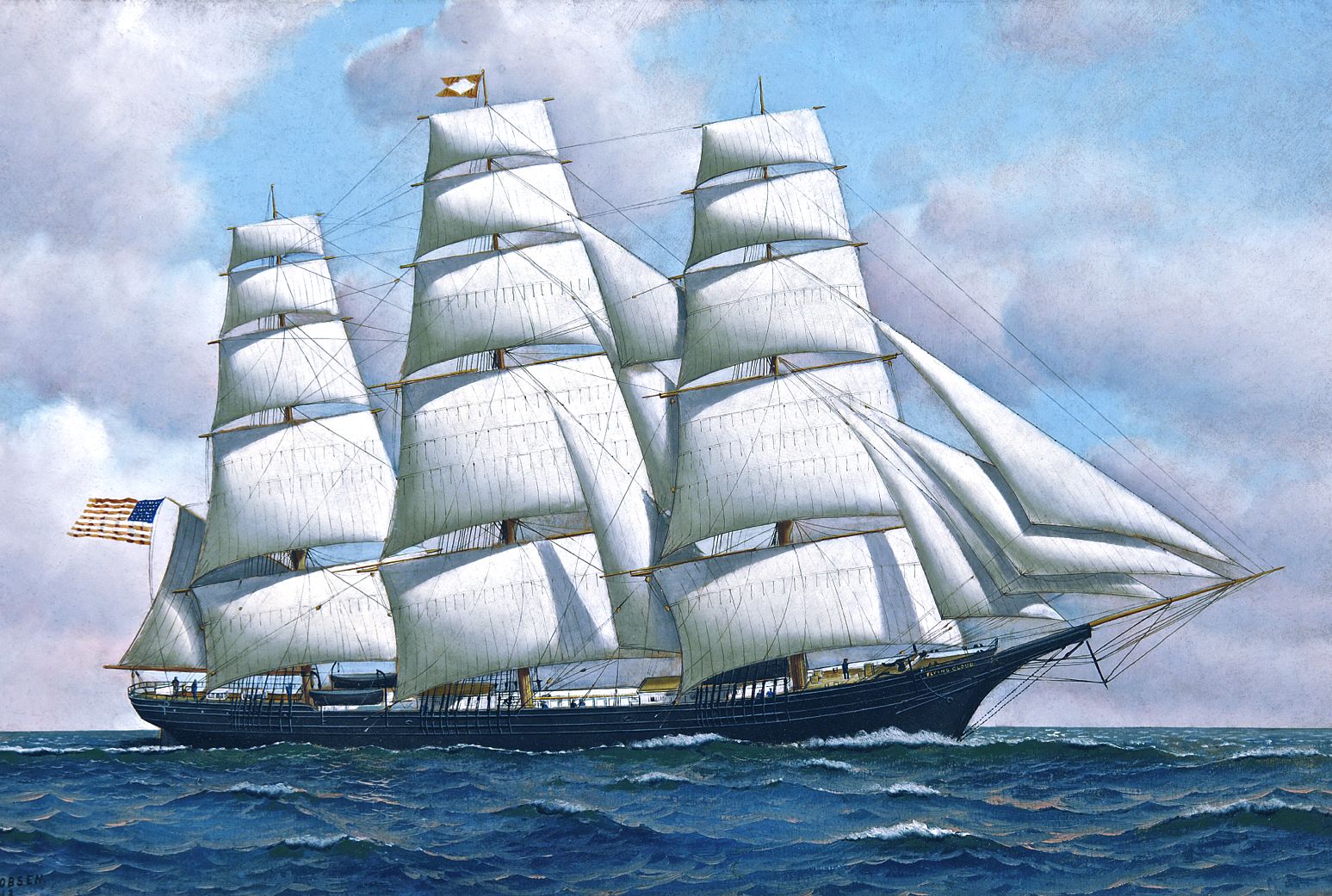
Title: Medallion Clipper Ship Flying Cloud Commemorative Silver Coin 1851
Catalog Number: 6292
Category: Metals / Metals
Artist:
Country & Origin: North America > United States
Historical Period: 20th Century
Approximate Date: 1972
Signature: Signed
Condition: Museum Quality
Size:
Height:
Width:
Depth:
Weight: 8.06 toz
Description & Provenance: Flying Cloud" 1851 clipper ship commemorative medallion. Total weight 8.06 toz. Old Medal. For The Collector An Antique Sterling Silver Presentation Medallion Coin. The coin is engraved with names of recipients and dates. Condition: Good. This sterling silver medal is part of the 60 pieces Longines Symphonette Great American Events Medal set. Clipper Ship Flying Cloud Silver Medal: It shows the clipper SS Flying Cloud, with all of her sails set. The Flying Cloud set the world record for the fastest sailing passage between New York and San Francisco (the journey took 89 days and 8 hours). She held this record from 1854 until 1989 when her record was finally broken by the Thursday’s Child. The reverse is covered in boring font, apparently written by someone who was unaware that their caps lock key was stuck. It reads “Clipper ships were grand examples of the shipwright’s art and their speed and grace aptly symbolized American expansion in the nineteenth century.” Below that, there’s a dyspeptic eagle at 6:00 on the medal, with an olive branch in its talons and its wings raised over its body. Date: 1972 Mint Mark: n/a Mintage: 5,000 (this one is from set P #4,224, which is stamped on the edge) Country of origin: United States of America Composition: Sterling Silver (92.5% silver) Size: 39 mm – it is slightly larger than a Morgan silver dollar, but this is not a coin. Weight: 34 grams (1.109 ounces of ASW) Other details: Longines is a watchmaker that sponsored a classical orchestra radio show in the 1940s called the Longines Symphonette. There were several different collections of silver medals made in the 1970′s to cross-promote the radio show and the Longines watch brand – this collection was produced along with Wittnauer Precious Metals Guild. This medal comes from the Great American Triumphs series of 60 medals. These were sold in complete sets, or in little red boxes that held two medals each. The boxes were labeled “The Wittnauer Precious Metal Guild / Symphonette Square, Larchmont, N.Y. 10538 / Makers of Fine Medallic Art”. These medals were produced in 92.5% silver and 99.99% silver. The edge of each medal is labeled with the composition (inscribed after “Longines Symphonette”). This one is labeled “Sterling”.
Origin, Encyclopedia & Researched Articles:
Encyclopedia Name: http://en.wikipedia.org/wiki/Flying_Cloud_(clipper)
The Flying Cloud was a clipper ship that set the world's sailing record for the fastest passage between New York and San Francisco, 89 days 8 hours. She held this record for over 100 years, from 1854-1989.
Flying Cloud was the most famous of the clippers built by Donald McKay. She was known for her extremely close race with the Hornet in 1853; for having a woman navigator, Eleanor Creesy, wife of Josiah Perkins Creesy who skippered the Flying Cloud on two record-setting voyages from New York to San Francisco; and for sailing in the Australia and timber trades.
Flying Cloud is popularly called an extreme clipper, as are many of Donald McKay's ships, but as her dead rise was less than 40" she was not. Donald McKay built many fast clipper ships but only one, the Stag Hound was an extreme clipper, even if others may have been advertised as such. It was popular to advertise clippers as "extreme" because of the popular conception of speed.
Flying Cloud was built in East Boston, Massachusetts, and intended for Enoch Train of Boston, who paid $50,000 for her construction. While still under construction, she was purchased by Grinnell, Minturn & Co., of New York, for $90,000, which represented a huge profit for Train & Co.
A reporter for the Boston Daily Atlas of 25 April 1851 wrote, "If great length [235 ft.], sharpness of ends, with proportionate breadth [41 ft.] and depth, conduce to speed, the Flying Cloud must be uncommonly swift, for in all these she is great. Her length on the keel is 208 feet, on deck 225, and over all, from the knightheads to the taffrail, 235— extreme breadth of beam 41 feet, depth of hold 21½, including 7 feet 8 inches height of between-decks, sea-rise at half floor 20 inches, rounding of sides 6 inches, and sheer about 3 feet."
Verbal History:
The clipper Flying Cloud:
In the fall of 1850, George Francis Train, Jr., the younger partner of Enoch Train & Co., most likely acting on his older cousin Enoch Train's orders, approached Donald McKay about building a new ship for the firm. This is how he described it in his memoirs that he wrote half a century after the fact:
When the gold fever was getting the country frantic, and everyone apparently wanted to go to California, I said to McKay, "I want a big ship, one that will be larger than the Ocean Monarch" McKay replied, "Two hundred tons bigger?" "No," said I, "I want a ship of 2000 tons." McKay was one of those men who merely ask what is needed. He said he would build the sort of ship I wanted. "I shall call her the Flying Cloud," I said.
George Francis Train, Jr., often referred to Enoch Train as his uncle. They were actually first cousins, twice removed, as their fathers were first cousins. After joining the firm as a junior clerk, he had steadily worked his way up to partnership. The above quoted passage is from his autobiography, My life in Many Lands, and this account may be embellished.
Enoch Train gave Donald McKay a free hand to design the Flying Cloud and this freed McKay's imagination to chase after in his mind just what his ideal of a extreme clipper ship designed for the Cape Horn run should be. The Surprise had been launched two months earlier at Samuel Hall's East Boston shipyard and perhaps Donald McKay was there in attendance and was most certainly familiar with Pook's latest extreme clipper. His ideas intrigued McKay. Pook espoused that a clipper with a full midship section and well-modeled ends was capable of being just as fast as a sharper ship of less carrying capacity. And in heavy seas the fuller bodied ship would have more stability and power and would be even faster than the sharper ship with big deadrise, thus making her the more seaworthy ship as well as carry more cargo.
In hindsight following the launching of the Stag Hound, Donald McKay could see that his first clipper ship, Stag Hound, was quite sharp with a deadrise of 40 inches, and those who attended her launching said that she resembled a yacht more than a commercial vessel.
While the loading of cargo went on at New York, some people thought the Stag Hound "overhatted" and at dangerous risk of being driven under by heavy seas. So much so in some eyes that New York maritime insurance underwriters had charged her owners a premium. Some historians have suggested that in light of this, Donald McKay decided to design the Flying Cloud with a fuller midship section and to scale down her masts and yards.
Soon, Donald McKay began carving away on his lift model constructed of cedar and pine layers of wood and held together with dowels. Meticulously, the Flying Cloud model that he saw in his mind's eye, recalled from his late night dreams, took on the shape that he intuitively desired, sanding and smoothing the model till it met with his exacting approval. This time around, he departed from the V-bottomed hull that he had designed for the Stag Hound and went with a more flat-floored hull.
McKay had learned his lessons well in the construction of water-line half-hull models from the master, Orlando B. Merrill, from his earlier days at Newburyport. Once he was satisfied with his workmanship, he removed the dowels and the rectangular slices of wood, known as "lifts," and one by one transferred the lines of each "layer" of the hull to graph paper called a "sheer plan" by maritime architects. The scale ratio translated out to one quarter of an inch for each foot of the ship, 48 times the original length of the lines. The lines were now ready to be transferred to McKay's huge mold loft that was the size of a ship. It was here that a full side of the Flying Cloud was charted in chalk with a different color of chalk used for each lift layer. The shape of each lift edge's chalkline on the mold loft floor showed the exact water lines of the hull at various depths. With his keen attentive mind and trained eye, Donald McKay had no trouble visualizing his one dimensional colored chalk lines of the Flying Cloud's three-dimensional hull.
McKay's choice of wood for the 208-foot keel was rock maple. This huge keel could not be obtained from one tree trunk, so it was constructed from separate sections using the tongue-and-groove method, fastened together and bolted down with iron driftbolts. Circular grooves were drilled over the length of the keelson and filled with salt pickle as a protection against rot, a method learned from Robert Bennett Forbes who had picked up this ingenious idea while visiting British shipyards.
Slowly, the ribs of the Flying Cloud grew out from the keel and keelson and the shape of the ship gradually emerged and soon a keen-eyed observer such as Henry Wadsworth Longfellow, who often visited and walked around McKay's shipyard, could make out her growing flat-floored hull. Inspired by the sight, he captured it all in a poem. George Francis Train always claimed that BY THE SEASIDE was a poem about the building of the Flying Cloud. Such lofty poetic lines as these leaves little doubt.












Comments are subject to review
Be the first to comment!